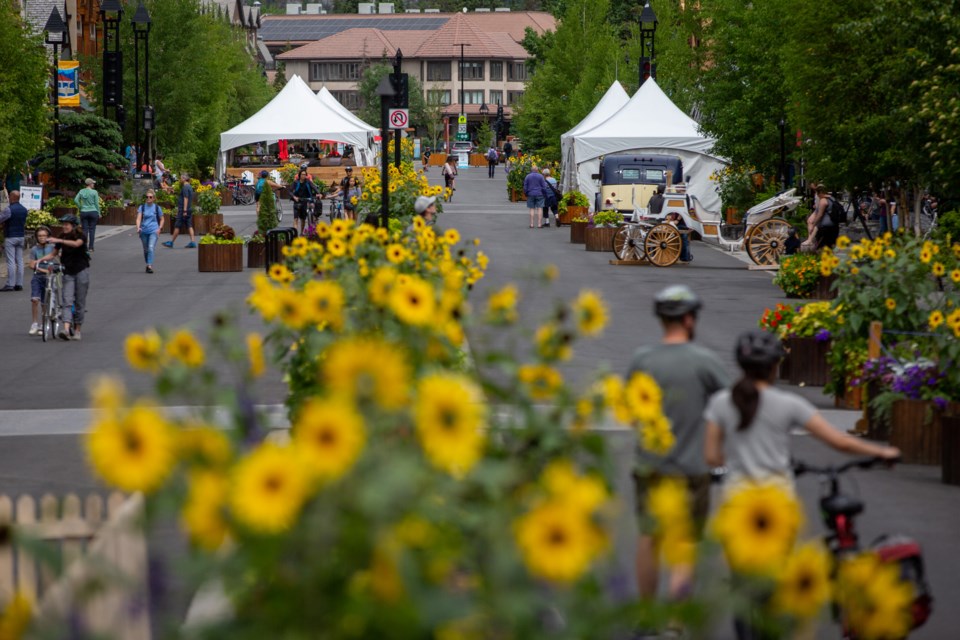BANFF – The number of tourists to Banff National Park this year is not far off previous visitation despite the COVID-19 pandemic.
Tourism officials say Banff National Park gate entry data shows the park is trending close to the same number of visitors as past years, noting visitation so far this year is down about 15 per cent over 2019.
“Essentially, visitation to Banff National Park has been quite strong through the summer, considering,” said Angela Anderson, a spokesperson for Banff & Lake Louise Tourism (BLLT).
“But not as many are staying overnight and taking their vacations here, thus hotels and activities in particular have been greatly impacted.”
In June, there were 271,296 visitors through the park gates versus 389,145 last year, which is approximately 33 decrease down from last year.
But visitation picked up in July with 581,202 visitors compared with 688,544 in 2019, a drop of about 15 per cent from the previous year.
Parks Canada hopes to have the August gate numbers available in the coming days.
“Year-to-date visitation numbers are down approximately 15 per cent over 2019,” said Anderson.
“Overall visitation this summer was stronger than expected.”
However, Anderson said hotel occupancy was significantly down this summer over last year, but better than expected.
“July occupancy was 46 per cent, increased considerably over June and exceeding the most recent occupancy forecast,” she said..
“Occupancy in July 2019 was 90 per cent – the most recent forecast was more around 25 per cent. Occupancy in June 2020 was 22 per cent; in 2019 it was 88 per cent.”
Anderson said businesses are incredibly grateful for the support of regional visitors during COVID-19.
But, she said, a lack of international tourists has “definitely impacted our destination.”
“International visitors spend much more while they are here and most businesses rely on international visitors,” she said.
Darren Reeder, executive director of Banff Lake Louise Hospitality Association, said overall hotel occupancy has proven to be stronger than forecast at the outset of summer.
“While definitely encouraging, this should not be confused with the sector’s revenue generation requirements, which have dropped precipitously as a function of not having international visitors in-market,” he said.
“Although long-haul domestic and international visitation to Alberta only represents about 16 per cent of all person visits, it accounts for 46 per cent of visitor spending within the province. This matters greatly to destinations like Banff and Lake Louise.”
The fall, Reeder said, is going to be tough without international visitors, meetings, conventions and Christmas parties.
“It will be critical that governments – at all levels – heed the advice of tourism industry leaders that ongoing fiscal stimulus supports – for example Canada Emergency Wage Subsidy program, further deferral, or abatement, of fees and taxes – will be required until such time that sector revenues return to a normative, pre-COVID-19 level.”
The federal government indicates the Canada-U.S. border remains closed to non-essential travel until at least Sept. 21.
“We do not expect international visitors to return until 2021,” said Anderson.
Meanwhile, a pedestrian zone in downtown Banff on the 100 and 200 blocks of Banff Avenue and portions of Caribou Street is set to reopen to vehicle traffic mid-September.
The pedestrian zone was set up to allow visitors to keep safe distances during COVID-19, but when visitation exploded beyond what was expected, a mandatory mask bylaw came into effect that included the outdoor downtown area.
A controversial plan also allowed businesses such as bars, restaurants and retailers to expand onto the street, given businesses were struggling with COVID-19 regulations on capacity limits indoors.
BLLT has been surveying its members on the pedestrian closure, and hopes to have results next week. The Town of Banff also sought public input through on online survey of residents and visitors.
At a meeting on Wednesday (Sept. 2), Banff’s municipal planning commission asked about the future of the pedestrian zone.
Darren Enns, the Town’s director of planning and development, said he believes the municipality’s survey results will come to council at the end of September or early October.
“That will be a chance for us to try to get some quantitive and qualitative feedback from those two cohorts on how they viewed the closure,” he said.
“I think that would help our elected officials make a decision on what to do next year.”
Enns said the success of people embracing the pedestrian zone in downtown Banff this summer is the driver for the design on the Bear Street shared street idea, which is currently under construction.
“The idea is that Bear Street will become very much a festival-pedestrian destination for our downtown,” he said.
“I’m really hopeful that come next year that it would be a magnet for pedestrian activity and so that’s another consideration.”
Meanwhile, heading into fall and winter, BLLT hopes Albertans and Canadians will continue to visit Banff National Park.
“We need Albertans’ – and Canadians’ – support to continue,” said Anderson.
“There’s a great opportunity to spend your vacation – or staycation – here and have an unforgettable time.”




